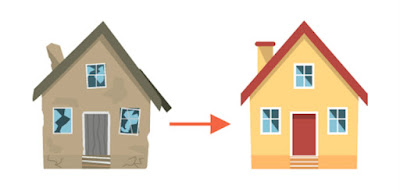Fall brings colorful leaves and cooler temperatures, but seasonal home care should also be on the calendar because winter has no mercy on homes unprepared for its surprises.
Roof and Exterior
A visual inspection of a home, from the chimney to the foundation, can help
reveal vulnerabilities that lead to trouble when wind, freezing temperatures,
snow or winter rains rule. Homeowners can use a drone or binoculars to look for
debris, which will need to be cleaned up, and missing or loose shingles, which
should be fixed or replaced before they lead to leaks. Overhanging tree limbs
should be trimmed, so they can’t come down, potentially puncturing the roof and
causing leaks, water damage and mold.
Gutters
To keep gutters running well, check them monthly for twigs, leaves and other
debris. Plan bigger cleanings — including running water down all the downspouts
— both before autumn leaves fall and again after trees are bare, to be sure
fall and winter rain and snowmelt can flow down and away from the house —
instead of into the walls, which can cause rot and mold and invite insects.

Some experts note that grass will fare better if it is fertilized after the hottest
days of summer are over, when the fertilizer can encourage blade growth and
strengthen the root system for winter. Rake off all leaves and give the lawn a
final mowing once it stops growing. (A local garden center can guide you on
fertilizer formulas suited to your climate and lawn.)
Outdoor pipes and water sources
Frozen water can burst pipes and hoses. Garden hoses should be detached and
drained. Outdoor faucets can be left on to drain after water to the outside is
shut off, says Mark Dawson, chief operating officer of a chain plumbing
business. He notes that irrigation systems should be blown out using an air
compressor or risk freezing — and having to replace irrigation lines come
spring.
Sealing a deck can help prevent damage from rain and snow. That means repairing or replacing loose or cracked boards, washing off dirt and mildew, vacuuming and applying a wood sealer. If a path through the snow on a deck is needed, consider using a shovel with a plastic or rubber blade to avoid damaging the wood.
Outdoor furniture
Umbrellas and furniture that could be blown over
can be brought inside or stacked and weighted down, to reduce the risk of
damage. Grills should be moved indoors and outdoors appliances such as mini
fridges should be unplugged.
Indoor Maintenance
Doors, windows and other drafty spots
To keep houses warm without sending heating bills through the roof, and to save
energy, the federal Environmental Protection Agency recommends sealing spots
where cold air can sneak in, focusing on the attic, foundation and around
windows and doors. Caulking, weather stripping and door draft guards can be
inexpensive DIY fixes.
Attic
Insulating the attic and sealing all gaps and cracks around recessed lighting,
plumbing, chimneys and other breaks in the attic floor — any place where warm
air can escape and cold air can sneak in — is the top recommendation of the
nonprofit Center for Energy and Environment. It pays for itself quickly in
reduced heating costs.
Heating
A good time for an annual HVAC system check — to look for wear in parts like
the blower motor — is before having to turn on the heat, according to the
International Association of Certified Home Inspectors.
Also, check with local utilities to see if they offer free energy audits or rebates
for energy-efficient appliances, including furnaces. It is also good practice
to change furnace filters every 60 to 90 days.
Basement
Along with cleaning gutters, making sure a basement is ready for winter means
checking the foundation for cracks, which freezing water can widen and make for
a very expensive repair. Sump pumps need to be checked for wear.
Miscellaneous
Fall is a good time to test smoke and carbon monoxide detectors and replace
batteries, according to the National Fire Protection Association.
Update first-aid kits for home and vehicles, replace flashlight batteries and
check that emergency go-bags are stocked with fresh water, food, medicines and
weather-resistant supplies to last at least 72 hours.
The big payoff is savings on repairs — and peace of mind. <
This article was brought to you
courtesy of Farmers Insurance agent, Jonathan Priest with an office at 57
Tandberg Trail, Suite 7, Windham.



